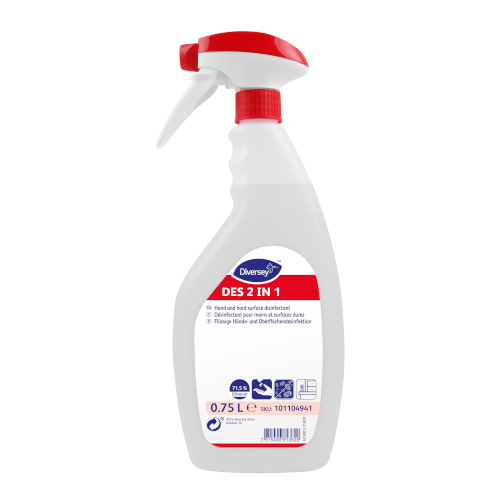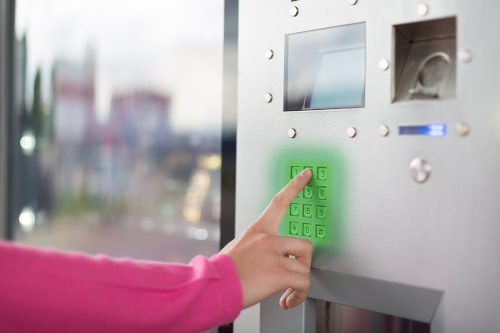Cleaning teams have a wider choice of products for surface disinfection than ever before. Conventional disinfectants are still widely used but novel formulations and innovative technologies support new and enhanced ways of working to complement or replace existing processes. That means that cleaning and infection prevention teams have unprecedented choice to make the best selection for their particular application and requirement.
Traditional liquid disinfectants containing active ingredients such as chlorine and quats are still widely used. The processes employed with these are established, understood, and trusted. These products work and they are generally economical in many settings. However, they are not suitable for every surface and many require users to wear PPE or take special precautions.

Formulations such as Diversey’s Oxivir range containing patented AHP (Accelerated Hydrogen Peroxide) as the active ingredient, on the other hand, can be used safely on a wide range of surfaces without many of the drawbacks of traditional disinfectants. These products offer what is known as broad-spectrum protection. This means they are highly effective against a wide range of viruses, spores, yeasts, and fungi, including C. diff, MRSA, Norovirus, E. coli, and Pseudomonas aeruginosa. Their efficacy has been tested to the latest EN standards, including EN14476 which covers viruses like the one that causes Covid-19. Oxivir products containing AHP have been shown to kill viruses in as little as 30 seconds and, when formulated as cleaner-disinfectants, are effective in dirty conditions.
Another approach is to use products containing at least 70 percent alcohol. This is the minimum level recommended by the WHO for effective hand and surface disinfection. Hand disinfectants and wipes containing alcohol have been widely used during the pandemic. They are simple to use and effective on many different surfaces and generally not harmful to skin. In many settings there are separate products for these two important applications. But a new type of formulation supports both in a single, convenient product. These two-in-one formulations – typified by Diversey’s Des 2in1 - avoid the need to switch between hand and surface disinfection products, saving time and keeping processes simple.

Replacing two products with one can also be more economical and avoids the need to buy, transport, and store multiple packs. These formulations are also suitable for use in disinfection devices such as hand hygiene kiosks and equipment that sprays product on to items such as trolleys and baskets at a supermarket entrance.
Disinfectants work by removing pathogens from a surface to reduce or eliminate the risk of infection. Generally, the more a surface is likely to be touched the more often it should be disinfected. In the most high-risk and critical settings such as healthcare this might mean that a surface should be disinfected after each time it is touched. However, the same frequency is not always required in applications where risks are perceived to be lower. But even here the frequency with which a surface is disinfected will have a bearing on the level of protection. In any case, none of the products mentioned above provide any meaningful ongoing protection after the surface has been disinfected. Any surface could become contaminated again as soon as it has been treated.
The challenge for suppliers has been to create a product that offers lasting protection. This was not possible until recently but a new type of product with these benefits is now available. Typified by Diversey’s new Degragerm 24, these products can be used to clean and disinfect small surfaces but, crucially, they offer ongoing protection against infections. They incorporate proven disinfectants and additional ingredients that form polymers. When applied, the product initially disinfects like a conventional formulation. But as it dries, its Advanced Polymer Technology creates a microscopic layer on the surface that holds the disinfectant in place. This means it can kill any pathogens that are subsequently deposited on the surface by touch or falling droplets. This is how these products offer long term or “after use” protection.
 |
Products that pass the BSI PAS 2424 Residual Antimicrobial Efficacy Test have been shown to offer protection for up to 24 hours. Degragerm 24 Shield passes this and the even more stringent EPA RSS test, in both cases in dirty conditions. This means it can be used as a cleaner-disinfectant and there is no need – unlike many alternative products - to clean the surface before it is applied.
In many commercial settings these new products offer an excellent new way to introduce and maintain high levels of protection on small areas and frequent touch surfaces. In these circumstances the ability to protect a surface after use can help cleaning teams to reduce the frequency of cleaning without significantly compromising general hygiene standards.
For example, cleaning teams that work through a facility and treat frequent touch points every couple of hours can reduce this to twice a day. This is the minimum recommended by bodies such as Public Health England for disinfecting frequently touched surfaces. Although the primary motivation for many cleaning teams will be cost saving, the newly freed time can be used to focus on other tasks that enhance the appearance of the facility or create a better impression for building occupants and visitors.
The growing choice of products and techniques for surface disinfection means there is probably a suitable solution for every setting and application. Choosing the right one, or a combination, to achieve the most effective and economical results can be bewildering. Reputable suppliers such as Diversey can advise on the pros and cons of each to help guide customers in their decisions.
